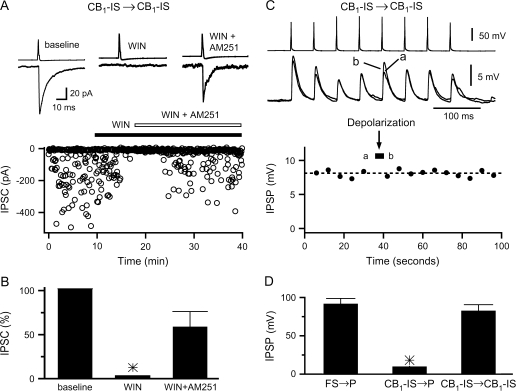Figure 2.
CB1-IS → CB1-IS synapses are suppressed by CB1 receptor activation but do not exhibit DSI. (A) Inhibitory connections among layer 2/3 CB1-IS neurons ([Cl−]in = 130 mM) are suppressed by the cannabinoid receptor agonist WIN55,212-2 (1 μM). The inhibitory transmission recovered after the addition of the CB1-selective antagonist AM251 (10 μM) indicating that the WIN effect was indeed mediated by the activation of CB1 receptors. The top panel shows the average responses (n = 200 IPSCs) in control (marked ‘baseline’), in the presence of WIN (marked ‘WIN’; n = 50 IPSCs), and in the presence of WIN and AM251 (marked ‘WIN + AM251’; n = 100 IPSCs). The lower panel shows the entire course of this experiment. (B) Summary data from 4 experiments among CB1-IS cells in layer 2/3. (C) Paired recording between 2 CB1-IS cells in layer 2/3. Both cells were recorded under current clamp, and internal chloride was 130 mM. A train of 8 action potentials at 20 Hz were generated in the presynaptic cell every 6 s (top panel). The traces in the top panel are averages of five 8-spike trains before and after postsynaptic depolarization. At the time labeled as postsynaptic depolarization, the 8 action potential presynaptic train was interrupted and a 4-s-long depolarizing current pulse (500 pA) was injected in the postsynaptic cell. Symbols in lower panel represent the average of 5 trials. (D) Summary data on the residual IPSP following postsynaptic depolarization for 3 types of synaptic connections. FS → P: 90 ± 7% (n = 6 pairs; 3 in layer 2/3 and 3 in layer 5); CB1-IS → P: 8 ± 2% (n = 7 in layer 2/3); CB1-IS → CB1-IS: 81 ± 8% (n = 4 pairs in layer 2/3).

